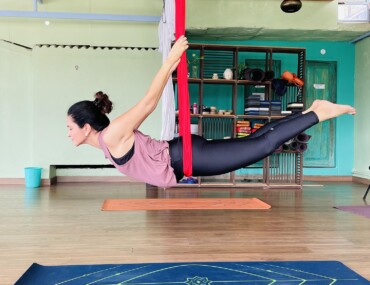A Heavenly Practice
Aerial yoga, a relatively new practice that has taken the fitness world by storm, offers a unique and exhilarating way to connect with your body and mind. By combining traditional yoga poses with the use of a hammock or aerial silk, aerial yoga provides a gravity-defying experience that challenges your strength, flexibility, and balance.
A Brief History of Aerial Yoga
While the roots of yoga trace back thousands of years to ancient India, aerial yoga is a more recent development. It is believed to have originated in New York City in the early 2000s. Early pioneers of aerial yoga, such as Michelle Dortignac, adapted traditional yoga poses to be performed in a hammock, creating a new and exciting form of exercise.
The Magic of the Hammock
The hammock, a key element of aerial yoga, plays a crucial role in enhancing the practice. It provides support and resistance, allowing for deeper stretches, increased range of motion, and a unique sensory experience. The hammock can be used to support the body in various positions, from inversions to backbends, making aerial yoga accessible to people of all fitness levels.
Health Benefits Claimed
Aerial yoga is not just a fun and exciting workout; it also offers a range of potential health benefits:
- Increased Flexibility: The hammock allows for deeper stretches, improving flexibility and range of motion.
- Improved Strength: Many aerial yoga poses require you to engage your core muscles, upper body, and lower body, leading to increased strength.
- Enhanced Balance and Coordination: Balancing in the hammock challenges your balance and coordination, leading to improved body awareness.
- Reduced Stress and Anxiety: The calming and meditative nature of aerial yoga can help reduce stress and anxiety.
- Improved Posture: Regular practice of aerial yoga can help correct postural imbalances and improve spinal alignment.
- Pain Relief: Aerial yoga can help alleviate back pain, neck pain, and other physical ailments.
Popular Aerial Yoga Poses
- Inversions: Aerial yoga offers a unique opportunity to practice inversions, such as inverted V, shoulder stand, and headstand.
- Twists: The hammock can support deep twists, helping to improve spinal flexibility and detoxification.
- Backbends: Aerial yoga allows for deeper backbends, such as wheel pose and camel pose.
- Forward Folds: Hammock-assisted forward folds can help relieve back pain and improve hamstring flexibility.
Aerial Yoga Teacher Training in India
If you’re passionate about aerial yoga and want to share its benefits with others, consider pursuing aerial yoga teacher training in India. India, with its rich yogic heritage, offers numerous opportunities to learn from experienced instructors and immerse yourself in the practice.
When choosing an aerial yoga teacher training program, look for:
- Experienced Yoga Instructors: Choose a program led by qualified and experienced yoga instructors.
- Comprehensive Curriculum: The program should cover anatomy, physiology, yoga philosophy, sequencing, and hands-on practice.
- Safe and Supportive Environment: The training should prioritize safety and provide a supportive learning environment.
- Certification: Ensure that the program offers a recognized certification upon completion.
By completing an aerial yoga teacher training program, you can embark on a rewarding career as an aerial yoga instructor, helping others discover the joy and benefits of this unique practice.
Soar High and Elevate Your Practice!




